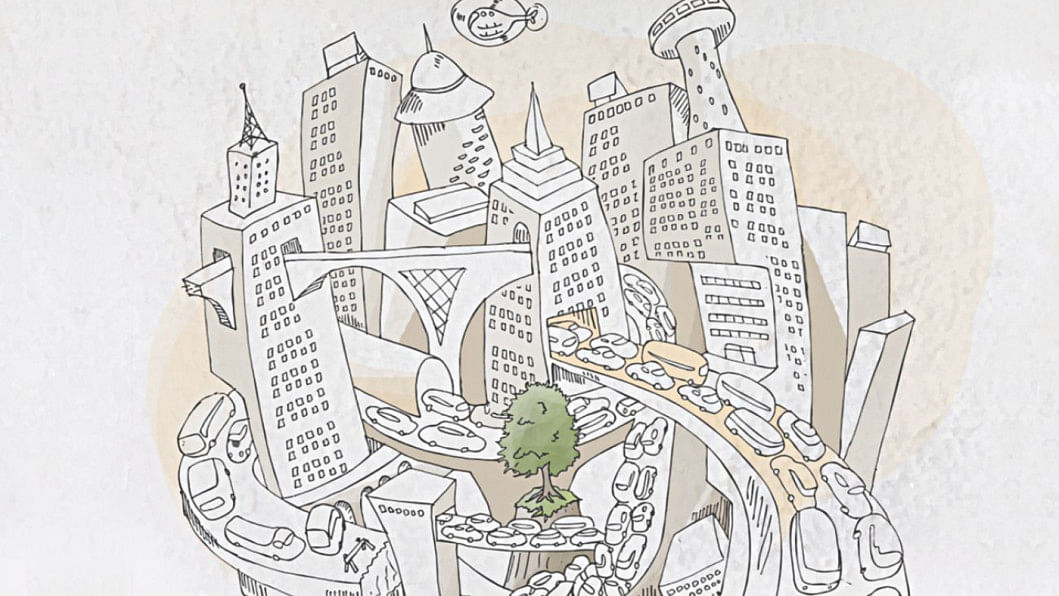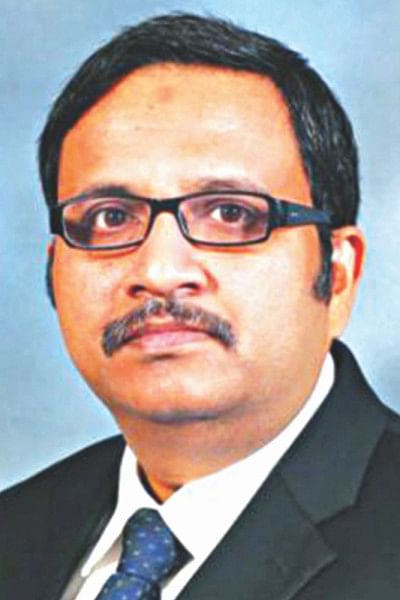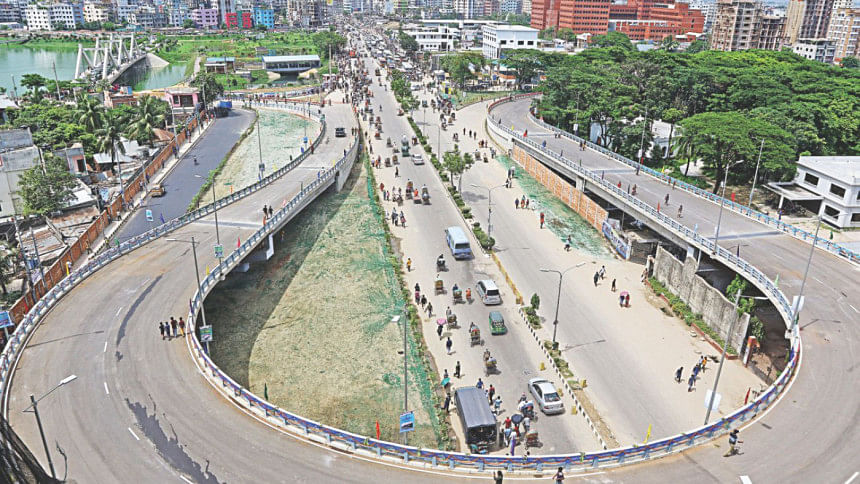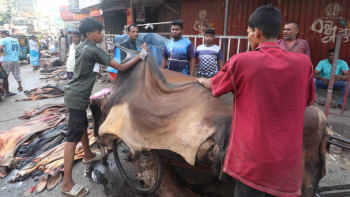Dhaka's transport sector: any sight of a bigger picture?

THE CURRENT PICTURE
A city of over 14 million, roughly 400 years of history, rapidly rising incomes and mass migration patterns that seems unsustainable to outsiders—yet somehow Dhaka survives against insurmountable odds. Dhaka is one of the world's largest megacities, yet there's not much that can be said to be large about it—except, perhaps, the number of people living in it and the number of people commuting its tightly packed thoroughfares. Over time, the city has endured, resolutely overcoming most major challenges, from sanitation to public services. The capital city has taken on a lot and survived. With a whole host of projects, including a growing flyover network and a well-hyped metro rail project, Dhaka seems to be attempting to shrug off the most persistent of its issues hindering sustainable liveability—its traffic and the city dwellers' struggle for mobility.

Will Dhaka city be able to resolve its mobility issues, courtesy of these government initiatives? According to Professor Dr Saiful Amin, the slew of transportation projects around Dhaka needs a cohesive plan of action for the future, instead of short-term relief. According to Dr Amin, “Flyovers built in Dhaka have been laid out mostly without planned diversion of the underground utility lines, creating a situation where, if Dhaka's transportation needs it next, we would not be able to build underground subway systems along the same routes, before shifting those again. The utility lines in some places have been moved once, in other places the deep foundations for the flyovers have had to accommodate the utility lines into their layouts, which means there is a significant problem in communication between city planners, utility service providers and the departments of the government building roads, flyovers and expressways. Over time, this hampers our ability to plan effectively and account for future demand.”
RISING DEMAND FOR ROAD SPACE
Dr Amin continues: “There's only a finite amount of space that is available for Dhaka's expansion. The city is bound by the rivers that flow around it, which are perceived by the dwellers as a physical restriction on the ability to increase the amount of liveable spaces and places for commerce. Connectivity with land masses beyond the river boundaries is still limited, failing to cater for the fast growing transportation demands originating from there. With living spaces and economic activities taking priority over road spaces, the strain on the city is extremely high, and growing. Places of economic and social importance are generating further traffic as a result of growing incomes all across the country, requiring a clear path to these places for people from all over the country. Traditional entry points into Dhaka city such as Jatrabari, Gabtoli and Tongi are almost always gridlocked for the sole reason of people wanting to enter the city to conduct their business at government institutions, which are currently far from decentralised.”
Providing road space for these visiting people alongside permanent city dwellers while meeting the demand for housing and commercial spaces seems like an impossible task, but careful planning and accounting for the future can lead to a more sustainable solution over time. Decentralising government offices and introduction of information technology, which demand less physical movement, can be a way forward, along with addressing all the different issues that lead to people making decisions that involve moving from one area of the city to another. “It's a common sight to see parents dropping off their children to schools which are far away from their houses. The logic behind this is that a certain school has a better standard of education than the locally situated one. Because of this difference in quality, trip generation is increasing on weekdays during school hours. The same issue is true for colleges and universities—only a few have limited residential campuses of their own. If there were zonal planning for Dhaka city with effective regulations, then much of this could have been avoided,” says Dr Amin.
RAPID TRANSIT
According to Dr. Amin, “The context in which the Strategic Transport Plan that included routes for metro rail and Bus Rapid Transits in Dhaka was initiated and developed has changed. The inbound and outbound traffic coming to the access points into Dhaka will
change drastically when the Padma Bridge is opened. Instead of two access points, South and part of North Bengal will be linked faster to Dhaka through Mawa, which will induce additional traffic in the Mawa–Zajira end and a reduction in the Daulatdia–Paturia Ferry route. The whole city's transport infrastructure will face a changed scenario, the mass transit system will face further challenges. Circular roads in the revised strategic transport plan can alleviate it, but implementation is still not seen to be in sync with the upcoming projects. All fast track mega projects should be in sync. The study that considered the feasibility of the mass transit system including the metro rail project needs to incorporate future demand in order to be a successful endeavour.”
The metro rail itself presents challenges of its own—for a population that has had access to but ardently ignored inter-city rail travel for the most part, questions remain about how effective it will be in enticing the masses to switch from buses to rapid rail transit. What happens to the buses? Will the government incentivise public transport via buses at the same time? Without any clear policy dictating how these elements will play out in the future, there's every chance that the metro rail project will not be as clearly beneficial to Dhaka's transport sector as has been claimed.

THE NEED FOR POLICY
Building flyovers or a metro rail project alone is not a sustainable solution to Dhaka's traffic woes, says Professor Amin. The steps need harmonisation between development efforts, plans and visions for the country. In the absence of such harmony, our traffic forecasts in numerals used for planning often remain far away from the ground conditions that a project sees after its implementation. A thorough understanding is necessary between the visions generating the demands and the efforts undertaken to ensure the supply. Close concerted perception is required among policymakers, planners and the engineering professionals of all implementing agencies.
“We need to match infrastructure development work with policies that seek to reduce the number of vehicles on the road. Whether it's through creating special economic, commercial or social zones and enforcing it, or through carpooling and High Occupancy Vehicle (HOV) lanes, or even congestion charges in certain areas, there are a significant number of policies that we might not have still looked into. We are failing to implement the land use area plans. One of the few attempts to control the number of trips generated daily on
Dhaka's roads, through allowing odd and even-numbered cars to ply roads on successive days, was found to be an ineffective policy. We need to refine our strategies in that regard and ensure that private vehicles will be allowed to move faster or enjoy some premium if they are filled to capacity,” says Dr Amin.
At the same time, attempts at planning ahead for the new satellite cities that are springing up around Dhaka should be streamlined between different government agencies so that mistakes can be avoided while
developing their infrastructure. Regions like Purbachal should get special attention. It is vital to develop the necessary transport links with present Dhaka and its zones.
THE ROLE OF TECHNOLOGY
As a driver of social change, technology certainly plays a crucial role. With Google traffic information, we can now choose the best route and congestion-free hours to initiate a trip, if our need can be met. With ride sharing apps operating in full swing, the average traveller on Dhaka's roads now has a significant number of choices in how they travel and what kind of transport is most effective. Uber and Pathao are disrupting the traffic patterns of urban areas in a good way, but they still need to be regulated properly to be effective. Smart sharing of traffic data, for example from Google, can help incorporation of congestion surcharge in ride sharing apps, in the bid to passively give commuters the choice of low cost trips in low congestions hours. Considering the initial conflict between the government's regulatory bodies and these ride sharing solutions, a point must be made about the government's forward thinking abilities. Letting Uber officially operate non-commercially registered vehicles may go a long way to creating an environment where private vehicle users can pick up passengers and effectively carpool to work, school or university, thereby reducing the number of vehicles on the road. The security concerns will remain, but a holistic approach to improving the transport sector is paramount.
IN CONCLUSION
The entire transport sector, with all the players involved, needs to move past the traditional mentalities that bind it and look, collectively, for a holistic, thorough and future-proof solution to the problems plaguing the beleaguered city of Dhaka. Short-term solutions or instant relief can only go so far in alleviating the suffering of the masses—rising incomes, a forward-driving economy and the correct environment for innovation demands long-term solutions.





Comments